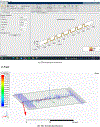EMF Antenna Exposure on a Multilayer Human Head Simulation for Alzheimer Disease Treatments
- PMID: 35663520
- PMCID: PMC9166144
- DOI: 10.4236/jbise.2022.155013
EMF Antenna Exposure on a Multilayer Human Head Simulation for Alzheimer Disease Treatments
Abstract
In this paper, we follow up with our preliminary biological studies that showed that Repeated electromagnetic field stimulation (REMFS) decreased the toxic amyloid-beta (Aβ) levels, which is considered to be the cause of Alzheimer's disease (AD). The REMFS parameters of these exposures were a frequency of 64 MHz and a Specific absorption rate (SAR) of 0.4 to 0.9 W/Kg in primary human neuronal cultures. In this work, an electromagnetic field (EMF) model was simulated using high-frequency simulation system (HFSS/EMPro) software. Our goal was to achieve the EM parameters (EMF Frequency and SAR) required to decrease the toxic Aβ levels in our biological studies in a simulated human head. The simulations performed here will potentially lead to the successful development of an exposure system to treat Alzheimer's disease patients. A popular VFH (very high frequency) patch microstrip antenna system was considered in the study. The selection was based on simple and easy construction and appropriateness to the VHF applications. The evaluation of the SAR and temperature distribution on the various head layers, including skin, fat, dura, the cerebrospinal (CSF), and grey matter, brain tissues, were determined for efficacy SAR and safety temperature increase on a simulated human head. Based on a current pulse of 1 A peak current fed to the antenna feeder, a maximum SAR of 0.6 W/Kg was achieved. A range of 0.4 to 0.6 SAR was observed over the various layers of the simulated human head. The initial design of the antenna indicated an antenna size in the order of 1 m in length and width, suggesting a stationary practical model for AD therapy. Future direction is given for wearable antenna and exposure system, featuring high efficiency and patient comfort.
Keywords: Alzheimer; Antenna; Brain Tissues; EM; Simulation.
Conflict of interest statement
CONFLICTS OF INTEREST The authors declare no conflicts of interest regarding the publication of this paper.
Figures










References
-
- Sideman AB, Al-Rousan T, Tsoy E, Escudero SDP, Pintado-Caipa M, Kanjanapong S, Mbakile-Mahlanza L, de Oliveira MO, De la Cruz-Puebla M and Zygouris S (2022) Facilitators and Barriers to Dementia Assessment and Diagnosis: Perspectives from Dementia Experts within a Global Health Context. Frontiers in Neurology, 13, Article ID: 769360. 10.3389/fneur.2022.769360 - DOI - PMC - PubMed
-
- Dement A (2016) Alzheimer’s Disease Facts and Figures, Alzheimer’s & Dementia: The Journal of the Alzheimer’s Association, 12, 459–509. - PubMed
Grants and funding
LinkOut - more resources
Full Text Sources
Miscellaneous
